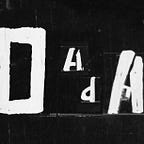The DADA robot that draws
By Judy Mam
We are collaborating with artist and roboticist Alexander Reben to create a GAN (a Generative Adversarial Network) that learns how to draw from our data set of over 115,000 drawings.
We call it the DADAGAN. It sounds like a dragon out of a monster movie, but we like it.
According to Wikipedia, a GAN is “a class of machine learning systems invented by Ian Goodfellow and his colleagues in 2014. Two neural networks contest with each other in a game… Given a training set, this technique learns to generate new data with the same statistics as the training set.”
This is a sample of the first batch of drawings generated by DADAGAN:
DADAGAN at Tate Modern
We are thrilled to introduce DADAGAN at our live interactive performance at Tate Modern on November 29, thanks to our friends from MoCDA, the Museum of Contemporary Digital Art.
DADAGAN will generate the first drawing of Screens: An Exploration, the collaborative visual conversation we are creating for the event.
Art Is Human. No Ifs, Ands, Or Bots!
There’s a lot of buzz about machines that make art. But we believe that art is a fundamentally human experience that involves much more than just logic. There is no art without intent. No bot can make art on its own.
In this case, Alex Reben has built the model and is training the DADAGAN so his hand is in the entire process, including the outcome since Alex and Beatriz are curating the drawings that it generates. Kat Mustatea, who is currently writing a book about art in the age of autonomous machines, says:
“Bots are like puppets, they have puppet masters. People — sometimes one, sometimes many — who programmed them to do something.”
We conducted a survey in English and in Spanish about people’s knowledge and attitudes about art made via machine learning. Those who were less familiar with generative art were more apprehensive and skeptical about the capabilities of robots to create art. There were many concerns about soullessness.
Beatriz, our founder, believes we have an opportunity to explore the philosophical, ethical and legal implications of art made by AI, and inform our community about how these technologies are used. As generative art curator Jason Bailey says:
“While most people misunderstand and fear artificial intelligence, I see AI as a tool to enhance human creativity. When human artists fail to sufficiently intervene in AI art, the output is bad. Implying, playing up, or misleading folks to believe that AI is making art on its own is not cool. Capitalizing on folks not understanding the tech to try and sell the work as having been made by a machine on its own is really not cool.”
Even though we know the machine is simply using logic, what is fascinating about generative art is the random appearance of something resembling human emotion or intention. The generative artist makes all the choices, but they never know exactly what they are going to get from the machine.
That’s the spooky part.
DADAGAN is already having conversations with our artists. You will note that DADAGAN goes by the pronoun “it”, because it is a machine. It created its own avatar, by the way.
But Why ?
In short: Because we can! We’re curious about how artists feel about DADAGAN’s drawings, and about interacting with it. We wonder if eventually DADAGAN could welcome new artists to DADA, and if it could learn to respond to drawings.
We want to explore if it’s possible for the DADAGAN to create quality artworks in tandem with our artists so that they can be shown at art galleries and sold to collectors. Eventually, the DADAGAN will become a Decentralized Autonomous Organization (DAO) that can create and sell its own artworks on the blockchain, thus helping us devise a system of decentralized community governance.
Legal scholar Primavera De Filippi thinks this generates interesting legal questions, such as:
“Do the GAN works qualify for a copyright on their own?
To which extent are the resulting works derivative works from the trained datasets?
Do they infringe on the previous works?
Who has the right to commercially exploit the resulting works?
Can the DAO license its copyright to third parties?
What kind of licenses are necessary to ensure that the DAO-GAN can operate freely?
Our Collaborators
Alex is an artist and roboticist who explores humanity through the lens of art and technology. His work probes the inherently human nature of the artificial. Alex has built robots for NASA, and is a graduate of the MIT Media Lab, where he studied human-robot symbiosis and art. He is a 2016–2017 WIRED innovation fellow, a Stochastic Labs Resident, and a recent visiting scholar in the UC Berkeley psychology department.
Jason is an artist, curator and art advisor. He is the man behind Artnome, an influential blog that specializes on the topics of digital art, blockchain art, and generative art. He has curated generative art shows at the Kate Vass Gallery in Zurich, and at Nanjing University, China. His work brings attention to artists working at the intersection of art and technology. He is also an advisor to DADA.
A technologist and playwright, Kat is a TED resident who speaks frequently about the intersection of cutting edge technology and art. She is currently a member of NEW INC, the art and tech incubator at The New Museum in New York City.
Primavera is a legal scholar, Internet activist and artist whose work focuses on the blockchain, peer production communities and copyright law. She is permanent researcher at the CNRS and Faculty Associate at the Berkman Klein Center for Internet & Society at Harvard University.
Let us know what you think!
